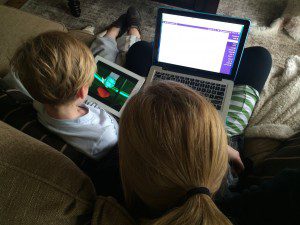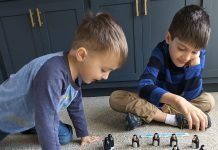Yesterday, when my daughter came home from school, I was informed that her class would be watching a full-length movie. I had to renegotiate what this would mean for our evening. A full-length film is 1.5 hours, and we stick to that as a total daily exposure rule. Sometimes we fudge – a child is sick, mommy’s pregnant and needs an extra 22 minutes and 30 seconds to nap, or a child needs a distraction to avoid derailing an afternoon errand run. I do it – I use my iPhone to keep my child occupied in boring situations where I might otherwise be judged for not controlling my 5-year-old. But then I’m judged for using my phone as a pacifier. We are the first generation forced to manage a screen-driven culture.
National Screen-Free Week reminded us of how wonderful days can seem when exposure to screens is eliminated. But unless you live among the Amish, you didn’t really go screen-free. We have exposure every time we step into public, pick up the phone, and send kids to school (Shawnee Mission announced in January that students would be given an iPad for home use). We cannot eliminate screens from our children’s lives – and quite frankly, that could backfire when they’re older and haven’t practiced screen-regulation.
Here are things to consider with 1.5 hours being the maximum cumulative amount of screen exposure on all devices:
1. Consider whether or not you want to associate screen time with reward or punishment.
While it seems like an effective tool for reinforcing/discouraging other behaviors, creating a negative association with no screen time may not help change other behaviors. Not having screen time is wonderful (outside play, make-believe, cooking, arts and crafts), but associating these things with punishment gives screens power. Instead, think of screen time as separate and only apply the provision/deprivation of screens in situations that are about the screens themselves. The consequence should be announced ahead of time (“if you scream about wanting TV, there will be no TV today”), related to the screen and reasonable in duration (not “you will not watch screens for a month”).
2. For teaching about how much time is allowed …
It’s usually first and second grade before kids can tell time so visuals are helpful for preschoolers and kindergarteners. Apps with a visual clock ticking down (we like “Timer Touch” for our iPhones) help them emotionally prepare for the show’s end. I created a 30-minute block schedule for each child, and the chart stayed on the fridge long enough to help the language of block timing take hold. I color-coded the time frames they were in school, homework, eating, bathing and sleeping, leaving white frames for the rest of the day. I explained they could “watch or play” approximately three frames each (1.5 hours) in the white spaces. We have Netflix and Hulu Plus which helps kids stop after each episode instead of experiencing one long, continuous screen-watching time. A Netflix show is 22-25 minutes, so the kids know that’s one white block – a “short show” – and they watch several. After a few months, the kids are able to track how many episodes they watch. Once they get to be 7+ years, they should have the ability to turn it off on their own.
3. Pre-plan how you will transition off the screen, rather than just saying “turn it off.”
Kids often need help transitioning from one activity to the next. Kids who are hungry, tired, stressed, or emotionally drained will have a particularly difficult time with transitions. Screens elicit dopamine (the same neurotransmitter associated with addiction) production in the brain. Your child isn’t being willfully ugly to you when you turn off the screen – there’s a set of chemical reactions happening in his/her brain. Finding an activity that helps children tolerate the “let down” effect teaches them how to help themselves with feelings of disappointment, anger, and loss when something enjoyable is taken away. The best way to help transition is to suggest a relationally connective activity. When your child feels connected (eye contact, touch, fun), they get a neurochemical boost that helps them cope.
4. Use screen choice to teach negotiation between siblings and parents/children.
Sometimes, I allow my two kiddos to watch separately while other times we save screen time for together time, when they must agree on a movie or shows. Sometimes it’s “you pick one, I’ll pick one, then we’ll pick one together.” Sometimes, they ask for extra time so they can each pick two shows to watch together. (Reminder: each show is 22-25 minutes, so four of these is a maximum of 1 hour and 40 minutes – still less than the American Academy of Pediatrics recommended 2-hour limit for children over 2 years of age.) Negotiation between siblings and between parents and children teaches mutual respect, and encourages the development of empathy – what many consider to be the most important human relationship skill.
5. Give language to what you want them to do.
Language development is supercharged in early childhood. Now’s the time to teach self-regulation vocabulary. We use terms like, “need to regulate,” “calm down,” “you need to agree about what to watch,” “you’re flipping your lid.”
- Appropriate = Does the show contain violent, sexual or suggestiveness? Use specific descriptions of
what you feel is inappropriate. For teens, discuss the risks of exposure to pornography, cyber-bullying, etc. - Regulate yourself = When a child turns off a device on their own, praise their self-regulation.
- Negotiate = Name cooperation when you see it!
 6. Be aware of what you are modeling with your own screen time.
6. Be aware of what you are modeling with your own screen time.
This is the hardest one for me. The truth is, adults spend lots of time using screens by necessity. As a full-time, self-employed mom, I work part of my week at home and am on-call most days. The world expects me to be available, so I make an agenda of things that need to be accomplished on my computer and a list of phone calls to return during afternoon screen time. Use your screen when you’re plugging in your child; unplug when you unplug your child. This means not scrolling through Facebook, Zulily, Etsy, playing Candy Crush or cleaning your inbox on your smart phone. When you plan screen time, sit next to each other and use accidental touch (a knee bump, a brush of your arm, shifting your weight) to stay connected and keep your child aware of your physical presence. Humans have brilliant little neurons in the prefrontal cortex that are called mirror neurons. Children literally mirror our behaviors because that’s how they learn. So do what you want them to do.
7. Build boundaries around meals, in cars, and bedtime.
Rituals, rules and traditions in families give children a sense of predictability, consistency and emotional security. When the brain is secure, it is better able to make good decisions and exercise self-control. Develop screen rules that everyone – adults included – obey.
- No phones or screens at the breakfast/lunch/dinner table. They are allowed at the physical location at other times, but calls/texts are ignored during meals.
- Screens do not belong in bedrooms. LCD screens decrease melatonin production, interrupting sleep-wake cycles. Screens in the bedroom can isolate individuals from the family and give children a sense they have power over the devices as property, making it harder to enforce rules.
- No cell phones at bedtime. This is a rule our kids devised for the parents so they could have our undivided attention during cuddle time. It’s also helpful for teens – cyber-bullying and inappropriate texting often happens after bedtime.
While they may protest, rules give children security in an unpredictable world. When it comes to the issue of screen usage, providing boundaries that flex as children develop gives them a better shot of self-regulating screens when they have to make the decisions for themselves.
For additional posts on this topic, read more here and here.
















